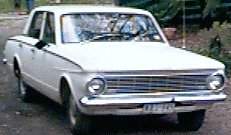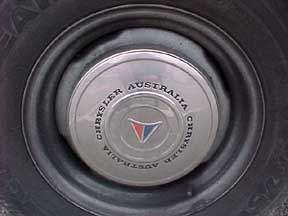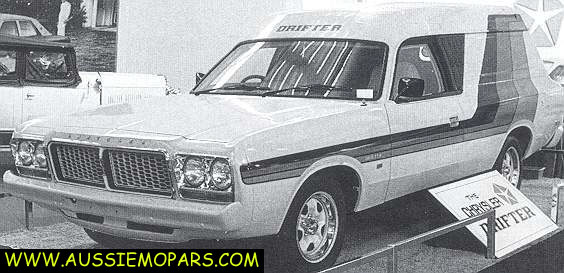|
|
|
History of Chrysler in Australia
The Valiant made a place for itself in Australian motoring history, mainly due to the heroic efforts of Chrysler Australia's engineering team. Their six cylinder engines and special body styles, such as the Charger, Utility, and Drifter, made the Valiant both unique and truly Australian, despite its USA roots. Though Chrysler eventually mismanaged its way out of Australia (and nearly out of existence), the Valiant remains a presence, and its racing record in New Zealand is unparalleled.
 |
Once upon a time, there was the Hemi Six Pack. Americans may quickly say that no such thing existed - and, in the US, it did not. There was the Hemi, a 426 cubic inch fire-breather (and its 1950s hemi-head predecessors); and there were Six-Packs, but only on 340s and 440s.
The Australian Hemi did not need eight cylinders. With its six hemispherical-head cylinders fed by triple Weber carbs, it easily outdistanced even Chrysler's own 340 and 360 V-8s. Powered by this straight six, the Valiant Charger is the fast accelerating production car made in Australia -- and it came out in 1972.
Why did Chrysler not realize what they had? Why did they even let their Australia division disappear? Why did they let some of their top talent go to Mitsubishi? Their failure speaks volumes about their ability to see the obvious.
The first Valiant to hit Australia was the Q: a single Q was imported in 1960 for evaluation, but after it was sold it was wrapped around a tree.
In January 1962, after the Plymouth Valiant turned out to be a success in the United States (starting with its 1959 introduction), Chrysler created the R, a locally-assembled (from mainly American components) version. It had a single engine, the 225 (3.7 liter) slant six, which was still exciting& and either a push-button Torqueflite automatic or a three-on-the-floor. It put out about twice the horsepower (145 vs 75) as the popular Holden and cost only about 10% more. This family sedan had a quarter mile time of 19.5 seconds and a top speed of 145 km/h.
Overall, there were 1,009 R series Valiants made.
The S series took over two months later, with a larger gas tank, better braking, lower maintenance, and a three on the column manual transmission. 10,009 S Series were made. The R and S Valiant club caters for these early models.
The AP5 (Australian Production 5) took over later, in 1963, with a more conventional look, a clean front end, and a serious investment (it was made in Tonsley Park, Australia). There was also a Regal version, adding some luxury. The AP5 was based on the equivalent American model.
 |
The AP5 (Australian Production 5) was much more Australian than the R and S Valiants, hence the name Australian Production (AP) name. They shared general body designs with the 1963-1966 American Valiants, but had a slightly different roofline and grille and trim differences. All these were 4 door sedans, 225 Slant Six engines, with Carter Carbs (except AP5, which had a Holley 1920). After the AP5 sedan was released they released a wagon and a V-8 (273ci) engine.
Chrysler couldn't build enough AP5s to meet demand; total sales were 49,440 in 22 months.
In March 1965, the AP6 came. The TorqueFlite was now column-shifted; otherwise, it was similar to the first R series. The speed advantage was evaporating, as the car became heavier and the competitors became stronger. Then the American 273 V-8 was introduced in the AP6 Regal body. It had a premium price, a top speed of 107 mph, and a 17 second quarter mile time. Its performance dominated the market, even with the smooth, reliable TorqueFlite.
Responding to Ford's optional V-8s, Chrysler introduced a 160 bhp slant six as a $60 option on all Valiants. Later, they also made the V-8 an option ($210) at all price levels, though disc brakes were now required (in a page from Ford's book). Prices now ran from $2500 to $3650.
The Valiant Utility ("ute") is now rare as there were only 2000 built, and many were used by farmers and as work vehicles. The utes came with a slant 6 engine out of the factory.
The AP6 was superseded by the VC series in 1966 (strangely, the AP5 and AP6 are not referred to as the VA and VB, which would seem to make sense). The VC model actually shared the same doors and structure as the AP6, but cleverly the Australian designers added a new nose and tail to give the impression of a much longer car. There was also the first long wheelbase option, which were known as either the "V.I.P." or Regal through the VE, VF and VG Series.
The VE model was based on the new 1967 A body (108" wheelbase up by 2") but combined Plymouth Valiant midsections with a Dodge Dart-like front design. Again, the sedans had a uniquely Australian roofline (the roof's trailing edge overhanging a complex-curved concave rear screen slightly reminiscent of contemporary Triumph sedans).
Rear end design was, as in the VC design, totally Australian as well. Chrysler Australia Ltd. produced a wagon version missing from the post-1966 US range and, at VF time, a hardtop coupe, but this was actually the Valiant front end (VFs and VGs had front and rear design unique to Australia) on the US Dodge Dart body (it used the latter's longer 111" wheelbase and had the just detectable kinked body crease at the hipline).
 |
The VIP did not begin until VE time as their offering in the extended wheelbase luxury sedan market (virtually invented by Ford's ZA Fairlane so it was really what the US saw as "midsize"); the name derived from an upmarket full-size Plymouth introduced to compete with LTD and Caprice in the mid '60s. I also believe the wheelbase was initially unchanged (i.e. 108") but probably around VF time it was extended to 112" and the styling made more distinctive (quad headlights, standard vinyl roof, frenched rear screen = US limousine!).
The VF was introduced in early 1969, and the 273 was replaced by its close relative, the 318 (which put out 230 hp gross, 150 net, and is still in production for trucks). The VF's heavier bulk countered the increased power, and the VF ended up being only a little faster with the 318.
Chrysler also brought out the sporty Pacer, powered by a high-performance slant six, beefed up suspension, floor-mounted four-speed, snarly exhaust, and built-in tachometer. The slant six put out about 170-180 hp, and the quarter mile was about 17.8 seconds.
The VG series brought new power (but not a new look) in 1970. Its new, Australian engine used hemispherical ("hemi") heads in a 245 cubic inch in-line six, a two-barrel carburettor, and a higher lift cam. The Pacer had a more powerful version of the same engine. The VG could run the quarter mile in 16.4 seconds; the Pacer, with a four-barrel carb, could do it in under 16. Sales were slow, probably due to the conservative body; the performance was beyond much of the competition.
| About [200] VG hardtops came with the buttress-like sail panel extensions, these were known as "Mexicanas" in Australia. |
The long wheelbase models in the VH, VJ and VK series were known as CH, CJ and CK. These long wheelbase models were known as the "Chrysler by Chrysler" and were loaded up with luxury items unseen in Australian made cars. They were available as four door sedans, or as a 2 door hardtop (with an enormous boot/trunk), and as they resembled elongated Valiants they still have a strange curiosity value today. They were introduced as a replacement for Chrysler Australia's previous "top-of-the-range" offering, the Dodge Phoenix, which was imported to Australia as a CKD (Complete Knock Down) kit, and assembled in Australia (using a variety of Australian Valiant parts, eg door handles, etc). The "Chrysler by Chrysler" range tended to be fitted out with power seats and windows imported from the USA.
Work on the powerful 245 was originally started in 1966 for American trucks, but it was never used (or finished) in the US! Chrysler never sought to use Australian ideas in the US, where the 265 Hemi Six-pack would have been the first of the really hot sixes.
Somewhere in the 1970s the Chrysler Centura, based on the Simca, came out.
The VG gave way to the VH in 1971. Though only slightly longer, the VH was five inches wider and designed to look even larger. It had three engines: the 215, 245, and 265, all domestic Hemis (though the 215 wasn't much of a performer). The 265 was a bored out 245, using the same pistons as the 318.
In 1962, Valiant stood for performance. By 1971, it was a conservative, staid family sedan. Just as the American 340 Duster's superb performance failed to impress Americans, the performance of the 265 Pacer failed to impress Australians.
Enter the Charger. Built on a shorter wheelbase, with a clean, sporty look, it was 130 kg lighter than any Valiant sedan, but it still had room for five.
 |
When the Australian designed VH series was introduced in 1971 the range of body styles was vast, there was the short wheelbase 2 door (Charger), there was the long wheelbase 4 door and 2 door (CH) as well as the standard wheelbase 4 door sedan, both short and long wheelbase 2 door hardtop, station wagon and utility (pickup) - a unique situation like this has not occurred since, and in fact the 2 door VH standard wheelbase hardtop model was soon dropped (and is now very rare and sought after).
The VH Pacer had a higher performance 265, and it set a record for being the fastest mass-produced four-door sedan with a six cylinder engine produced in Australia (the record was undisputed until 1998).
The 1972 E49 Charger was another significant move forward, and not just because it was the first to get a four-speed manual gearbox (from Borg-Warner). The E49 pushed the 265 engine to a full 302 hp, and had the quickest acceleration of any Australian production car - 14.1 seconds, respectable even when compared to American big-blocks.
The 340 V-8 was Chrysler's last high-performance V-8 intended for cars. In the American Dusters, it was a match for many big-blocks, but was often underestimated in the US (and in Australia, where it was the first high-performance V-8 to be offered in a Valiant or Charger). With an automatic, its performance was better than the manual XA GT Falcon. Zero to sixty (mph) was 7.2 seconds, and the quarter mile was an impressive 15.5; top speed was over 200 km/h. The camshaft was non performance (same as that of the 318) and the exhaust was restrictive, so it was capable of much more.
In 1976 the CL Series of Valiants was launched, it had the same wheel base as the VH, VJ and VK, and the long wheelbase Chrysler by Chrysler was dropped.
The CL series introduced the first Valiant "Panel Van" model, which it was claimed was the result of intense market research by Chrysler Australia (GM Holden and Ford had been offering panel van derivatives since the 1960s). No-one was surprised when this panel van turned out looking like a Utility with a roof. In the CL series sports versions of the Panel Van and Utility were offered during the panel van craze of the late 1970s (to compete with Holdens "Sandman" and Ford's "Sundowner") and these were known as the "Drifter" (a critic apparently claimed the name described the torsion bar/leaf spring handling). Drifters were fitted with a Charger honeycomb grille, wide side stripes, blackout treatment around the side windows, and styled steel wheels, the panel vans have a huge black triangular plastic fitting behind the front door window that resembles an air vent but may not have any function. Drifters also were probably fitted with upgraded suspension, and any number of other options. Drifter Panel Vans are fairly common, but apparently less than ten Drifter Utilities were actually produced, and are now quite rare.

The Chrysler "Drifter" Panel Van
When the CL series Charger disappeared in 1978, the last sports model Valiant was the CM series Valiant GLX. The name "GLX" is still used by Mitsubishi Australia, who by 1978 were half owners of the Valiant factory (taking full ownership in October 1980), and Valiant under bonnet compliance plates were starting to have "Mitsubishi" printed on them, and referring to the "Chrysler" name as being used "under license from Chrysler America."
The GLX had substantially upgraded suspension, referred to as Radial Tuned Suspension. Allegedly, a Valiant was shipped to America to have the suspension tuned further, and it was returned with Chrysler stating that the Valiant had better handling than any large car they had produced. The GLX was also fitted with a 4 speed floor shift Borg Warner gearbox, and the Electronic Lean Burn (ELB) 4.3 Litre Hemi 6 cylinder; this combination was in the right hands able to achieve fuel economy of over 30 miles per gallon (Imp.). Nevertheless, customers after sports handling had left the Valiant for the newer generation Australian cars, such as the Holden Commodore and XD Falcon. The GLX can be identified by a black stripe down the side (similar to the "Drifter"-style stripe) that ends at a "GLX" badge on the rear C-pillar.
The CL and CM models lost sales and performance. Later cars were designed to look bigger than they were, which played well in the US, but not in Australia. By the 1970s, buyers in both countries wanted large interiors, small exteriors. There were also quality problems each time a model was introduced. There was insufficient support for racing. The Charger died in 1978, and took with it much of the Valiant's sales, and all of Chrysler's production performance except limited edition American turbo's and the Viper.
Competition from Toyota and Nissan hurt, though the Sigma, a Mitsubishi with a Chrysler badge, sold well. There was some talk in the late 1970s of bringing K-cars (Reliant/Aries) into Australia, but it never happened. The last Valiant was the N, and it never saw production. Mitsubishi took over Chrysler Australia.